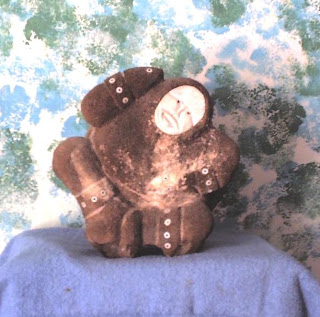“It’s made of whale bone,” I was told, “Carved from vertebrae”.
 |
| The Inuit whalebone statue - drummer side |
At first glance the 14-inch figure looks quite sombre: a drummer, cross-legged and hunched inside the warmth of a thick coat. The lines are smooth, but the surface of the bone is porous, giving it a cold feel to touch. Why was it carved? A toy passed between giggling children in neighbouring boats? A present? Maybe whilst you’re holding it wondering if something with so much care poured into it could really be a trinket for tourists, you feel that the back of the statue is also carved, and spin it around: The statue has two faces. A drummer and a dancer.
The faces themselves, along with the buttons on their coats and the drummer’s traditional qilaut drum are ivory – suggested to be from a Walrus tusk. But, wait a minute… ivory… whalebone… surely they’re protected materials? There are no descriptive markings on the statue – no “igloo tag” issued by the Canadian government, no Roman numeral or syllabics on the base. We’re told:
“the USA has a strict ban on imports of any type of whale bone unless there is a DNA test result which states the species of whale it came from.”
 |
| The Inuit whalebone statue - dancer side |
So is the little statue illegal? Should it be destroyed? We’re told a lot of whalebone isn’t signed, so the only way to be sure is to find someone who recognises the statue.
A gallery in Vancouver, British Columbia told us the statue might be from the Ivujivik region, in the eastern Arctic. They have a contact in a western Arctic community of Inuvik, a town of 4,000 people which translates as “the place of man”.
“Pieces do move about, even up there,” the gallery said, but, “we have not had a lot of success in direct approaches to our Inuit contact, he never answers his email.”
Do you recognise the statue? Contact The Thing Detectives, or tweet to us @ThingDetectives.
